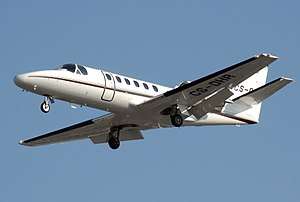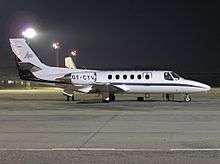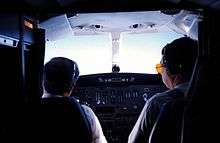Cessna Citation II
The Cessna Citation II (Model 550) series of Citation jets are light corporate jets built by Cessna. Stretched from the Citation I, it was announced in September 1976, first flew on January 31, 1977 was certified in March 1978. The II/SP is a single pilot version, the improved S/II first flew on February 14, 1984 and the Citation Bravo upgraded with new avionics and P&WC PW530A turbofans on April 25, 1995, while the United States used it as the T-47. Production ceased in 2006 after 1184 were delivered.
| Cessna Citation II / IISP / SII Citation Bravo | |
|---|---|
 | |
| Role | Corporate jet |
| National origin | United States |
| Manufacturer | Cessna |
| First flight | 31 January 1977 |
| Produced | 1978–2006 |
| Number built | 1184 : 688 II, 336 Bravo, 160 S550[1] |
| Developed from | Cessna Citation I |
| Variants | Cessna Citation V |
Design

The Citation II (Model 550) stretches the Citation I fuselage by 1.14m (3ft 9in), increasing seating capacity to 10 and baggage capacity. Wingspan was increased, its larger fuel capacity and more powerful, 2,500 lbf (11 kN) Pratt & Whitney Canada JT15D4 engines provided higher cruise speeds and longer range.[2]
Development

The stretched Citation was announced in September 1976, it first flew on January 31 1977 and FAA certification was awarded in March 1978, the II/SP is the single pilot version.[2] A total of 688 aircraft were delivered.[1]
The improved Citation S/II (Model S550) was announced in October 1983 and first flew on February 14, 1984, before certification in July. It gained a supercritical airfoil developed for the Citation III and JT15D4B turbofans. It replaced the II from 1984, but the II resumed production from late 1985, and both were built until the Bravo introduction.[2] Deliveries of the S/II amount to 160.[1]
The improved 2,500 lbf (11 kN) JT15D-4B has higher temperatures components, allowing more thrust at higher altitudes. It could seat 11 people and fuel capacity was increased to 5820 lbs. TKS fluid de-icing was used on airfoils leading edges in addition to bleed air for the engines.
By 2018, 1970s-1980s model IISPs were valued at $300,000-700,000.[3]
Citation Bravo
The Citation Bravo first flew on April 25, 1995, was granted certification in August 1996 and was first delivered in February 1997. It features new P&WC PW530A turbofans, modern Honeywell Primus EFIS avionics, a revised Citation Ultra interior and a trailing link main undercarriage.[2] Production of the Bravo ceased in late 2006 after 336 had been delivered.[1]
Its more efficient PW530A generates 15% more thrust at takeoff and 23% more at altitude. It burns 1,100 lb (500 kg) of fuel in the first hour, dropping to 750–830 lb (340–380 kg) the second hour cruising at 360–365 kn (667–676 km/h) at FL410-430 and then 637 lb (289 kg) the third hour at 350 kn (650 km/h) and FL450. The engine overhaul every 4,000 hours cost $1 million or $275 at power by the Hour. In 2018, early 1997 models starts at $800,000, up to $1.7 million for 2006 planes. The Bravo was replaced by the better-but-more-expensive Citation CJ3. The competing Beechjet 400A is roomier and faster but needs more fuel and more runway while the compact Learjet 31A competitor is faster but has less range. The faster and more expensive Citation V Ultra's have a longer cabin but consume more fuel.[4]
Government variants

The US Customs & Border Protection purchased ten Citation IIs configured with fire control radar (initially the F-16's AN/APG-66(V), later the Selex ES Vixen 500E system) and the WF-360TL imaging system.[5] These aircraft have been used effectively in Panama, Honduras, Colombia, Peru, Venezuela, Mexico and Aruba. The similar OT-47B aircraft are based on the Cessna Citation V airframe.
The Model 552 T-47A was the designation given by the U.S. Navy to the Citation II. Fifteen aircraft were purchased by the Navy to train Naval Flight Officers, primarily its Navy F-14 Tomcat Radar Intercept Officers, Navy and Marine Corps A-6 Intruder Bombardier/Navigators, Navy and Marine Corps EA-6B Prowler Electronic Warfare Officers, Marine Corps F/A-18D Hornet Weapon Systems Officers and Navy S-3 Viking Copilot/Tactical Coordinators. The T-47A was modified by incorporating JT15D5 engines, shortened wings, multiple radar consoles and the AN/APQ-167 radar system.[6]
The T-47As were operated by Training Air Squadron Eighty Six (VT-86), which was based at Naval Air Station Pensacola, Florida. All but one of the T-47As were destroyed in a hangar fire, and the Navy replaced them with upgraded T-39s[7]
Variants
- Citation II (Model 550) a larger stretched development of the Model 500 first produced in 1978. Initially replaced by the S/II in production, but was brought back and produced side-by-side with the S/II until the Bravo was introduced.[2][8]
- T-47A (Model 552) is the military designation of the Citation II. The United States Navy purchased 15 T-47A aircraft as radar system trainers.
- Citation II/SP (Model 551) single-pilot operations[2][9]
- Citation S/II (Model S550) incorporated a number of improvements, especially an improved wing. Replaced the II in production.[2][10]
- Citation Bravo (Model 550) updated II and S/II with new PW530A engines, landing gear and Primus 1000 avionics.[11][12] The last Citation Bravo rolled off the production line in late 2006, ending a nearly 10-year production run of 337 aircraft.[13]
Operators

Military operators




- Myanmar Air Force





- Spanish Air Force
- Spanish Navy[18]
- National Police Corps of Spain




Airline operator
The Citation was also operated by at least one airline in scheduled passenger service being Enterprise Airlines in the U.S. from the late 1980s to 1990.[20] [21]
Specifications (Cessna S550 Citation SII)

Data from Jane's All the World's Aircraft 1993–94[22]
General characteristics
- Crew: Two
- Capacity: Six to eight passengers
- Length: 47 ft 8 1⁄2 in (14.542 m)
- Wingspan: 52 ft 2 1⁄2 in (15.913 m)
- Height: 15 ft 0 in (4.57 m)
- Wing area: 342.6 sq ft (31.83 m2)
- Airfoil: NACA 23000[4]
- Empty weight: 8,059 lb (3,656 kg)
- Max takeoff weight: 15,100 lb (6,849 kg)
- Fuel capacity: 862 US gal (718 imp gal; 3,260 L) usable fuel
- Powerplant: 2 × Pratt & Whitney Canada JT15D-4B turbofans, 2,500 lbf (11 kN) thrust each
Performance(above 29,315 ft (8,935 m))
- Maximum speed: Mach 0.721
- Cruise speed: 403 kn (464 mph, 746 km/h) at 35,000 ft (11,000 m)
- Stall speed: 82 kn (94 mph, 152 km/h) (CAS)
- Range: 1,998 nmi (2,299 mi, 3,700 km) (with max fuel)
- Service ceiling: 43,000 ft (13,000 m) (max operating altitude)
- Rate of climb: 3,040 ft/min (15.4 m/s)
See also
Related development
- Cessna Citation series
- Cessna Citation I
- Cessna Citation V
Aircraft of comparable role, configuration and era
References
- "500-Series Technical Review". Textron Aviation. 28 April 2015.
- The Cessna Citation II & Bravo from Airliners.net
- Mark Huber (December 2018). "For many models, market hitting the apex" (PDF). Aviation International News. pp. 20–21, 24.
- Fred George (26 February 2018). "Second-Generation Citation II Is Cost-Effective Entry-Level Jet" (PDF). Business & Commercial Aviation. p. 58.
- Cessna C-550 Fact Sheet Retrieved 21 August 2011.
- Model Designation of Military Aerospace Vehicles, Department of Defense, Publication DoD 4120.15-L, 12 May 2004
- Global Security.org article on the T-47A
- Citation II info from Aviation Safety Network
- Citation II/SP info from Aviation Safety Network
- Citation S550 info from Aviation Safety Network
- "Cessna Citation Bravo Light Business Jet Cessna Citation Bravo Light Business Jet, USA", Aerospace-Technology.com
- Citation Bravo info from Aviation Safety Network
- Cessna Press Release Recent Milestones for Cessna’s Citation Business Jet Programs Archived 26 February 2008 at the Wayback Machine 17 July 2006
- Hoyle Flight International 8–14 December 2015, p. 32.
- Hoyle Flight International 8–14 December 2015, p. 37.
- Hoyle Flight International 8–14 December 2015, p. 45.
- Hoyle Flight International 8–14 December 2015, p. 47.
- Hoyle Flight International 11–17 December 2012, p. 60.
- Hoyle Flight International 8–14 December 2015, p. 53.
- http://www.departedflights.com/BE060390intro.html
- http://www.departedflights.com/BEproplessproposal1090.html
- Lambert 1993, pp. 465–466.
- Hoyle, Craig. "World Air Forces Directory". Flight International, Vol. 182, No. 5370, 11–17 December 2012. pp. 40–64. ISSN 0015-3710.
- Hoyle, Craig. "World Air Forces Directory". Flight International, Vol. 188, No. 5517, 8–14 December 2015. pp. 26–53. ISSN 0015-3710.
- Lambert, Mark. Jane's All the World's Aircraft 1993–94. Coulsdon, UK: Jane's Data Division, 1993. ISBN 0-7106-1066-1.